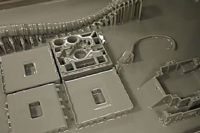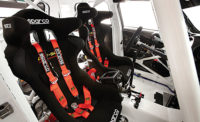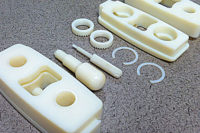Most rapid prototyping service providers specialize in one area of additive manufacturing, such as fused deposition modeling (FDM) or metal sintering. ZARE SrL, however, offers expertise in several areas.
Based in Boretto, Italy, ZARE began in the mid-1960s as a manufacturer of precision machines, but became a rapid prototyping services firm in 2009. Today, it offers a variety of additive manufacturing technologies, including FDM, direct metal laser sintering (for any metal alloy), selective laser sintering (for small-quantity lots or small components for assembly), stereolithography (to produce highly detailed models) and vacuum casting (from a master prototype).
The company’s range of additive manufacturing services was not always so extensive. Initially, ZARE only made large monolithic prototypes using metal sintering. In 2011, the company added prototype surface finishing, lamination and reverse engineering. Last year, ZARE greatly expanded its capabilities by investing in a fleet of Fortus 3D production systems made by Stratasys Ltd.
“After a steady decline in traditional manufacturing business, these [systems] have given us an edge over our competition and enabled us to reduce manufacturing costs for our customers by 50 percent,” says Andrea Pasquali, R&D manager for ZARE. “This has been the key to revitalising our direct manufacturing business, [enabling us to] quickly produce durable end-use parts in the final material.”
According to Pasquali, the 3D systems have cut iteration costs, shortened turnaround times and reduced the cost-per-final-part by around 30 percent. These systems are used in various applications, including injection molding, tooling and final parts production.
For one aerospace customer, ZARE 3D printed and function tested a pipe made of FAA-approved ULTEM 9085, a high-performance thermoplastic material from Stratasys. Engineers at ZARE soon realized that the material’s FST (flame, smoke and toxicity) rating and high strength-to-weight ratio matches that of various metals.
“By replacing metal-manufactured parts with high-performance thermoplastics, our [aerospace] customers can meet a vital requirement of aircraft manufacturing: reducing overall weight,” explains Pasquali. “[They can also] maintain production quality and adhere to passenger safety requirements. A great example of this is directly manufacturing lightweight air conditioning ducts.”
Since installing the 3D systems in early 2015, ZARE has significantly increased its business, with automotive and aerospace manufacturers now accounting for nearly 50 percent. Equally important, the wide range of 3D printing materials available from Stratasys enables the company to match select characteristics of traditionally manufactured metal parts at a fraction of the weight and cost.
“We now [print] car bumpers in ASA (acrylonitrile styrene acrylate) to leverage its high UV stability,” notes Pasquali. “And [we make] headlights in PC-ABS (polycarbonate acrylonitrile butadiene styrene), which combines both the superior strength and heat resistance of PC and the flexibility of ABS.”
For more information on 3D printing systems and materials, call 877-489-9449 or visit www.stratasys.com.





